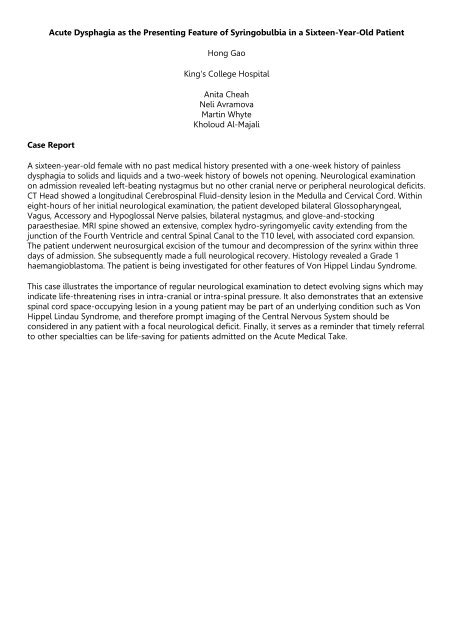Case Report ABSTRACTS
Case-Report-Abstracts
Case-Report-Abstracts
Create successful ePaper yourself
Turn your PDF publications into a flip-book with our unique Google optimized e-Paper software.
Acute Dysphagia as the Presenting Feature of Syringobulbia in a Sixteen-Year-Old Patient<br />
<strong>Case</strong> <strong>Report</strong><br />
Hong Gao<br />
King's College Hospital<br />
Anita Cheah<br />
Neli Avramova<br />
Martin Whyte<br />
Kholoud Al-Majali<br />
A sixteen-year-old female with no past medical history presented with a one-week history of painless<br />
dysphagia to solids and liquids and a two-week history of bowels not opening. Neurological examination<br />
on admission revealed left-beating nystagmus but no other cranial nerve or peripheral neurological deficits.<br />
CT Head showed a longitudinal Cerebrospinal Fluid-density lesion in the Medulla and Cervical Cord. Within<br />
eight-hours of her initial neurological examination, the patient developed bilateral Glossopharyngeal,<br />
Vagus, Accessory and Hypoglossal Nerve palsies, bilateral nystagmus, and glove-and-stocking<br />
paraesthesiae. MRI spine showed an extensive, complex hydro-syringomyelic cavity extending from the<br />
junction of the Fourth Ventricle and central Spinal Canal to the T10 level, with associated cord expansion.<br />
The patient underwent neurosurgical excision of the tumour and decompression of the syrinx within three<br />
days of admission. She subsequently made a full neurological recovery. Histology revealed a Grade 1<br />
haemangioblastoma. The patient is being investigated for other features of Von Hippel Lindau Syndrome.<br />
This case illustrates the importance of regular neurological examination to detect evolving signs which may<br />
indicate life-threatening rises in intra-cranial or intra-spinal pressure. It also demonstrates that an extensive<br />
spinal cord space-occupying lesion in a young patient may be part of an underlying condition such as Von<br />
Hippel Lindau Syndrome, and therefore prompt imaging of the Central Nervous System should be<br />
considered in any patient with a focal neurological deficit. Finally, it serves as a reminder that timely referral<br />
to other specialties can be life-saving for patients admitted on the Acute Medical Take.




